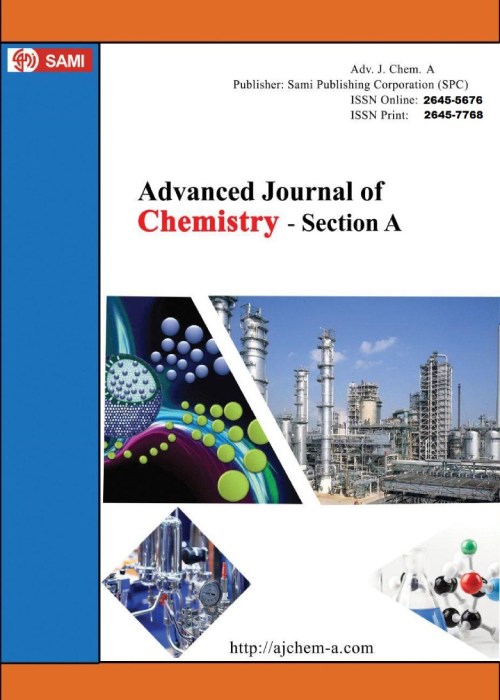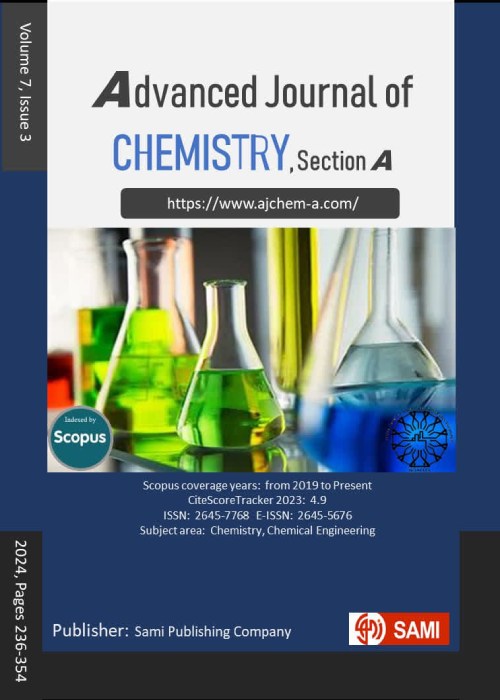فهرست مطالب

Advanced Journal of Chemistry, Section A
Volume:6 Issue: 2, Spring 2023
- تاریخ انتشار: 1402/01/12
- تعداد عناوین: 7
-
-
Pages 92-104Hepatocellular carcinoma is recognized as a major cause of cancer-related deaths worldwide and has been a healthcare burden globally. In the search for novel chemotherapeutic agents for treating this disease, a set of benzimidazole-chalcone derivatives with proven inhibitory activities against HepG2 cancer cell line were subjected to QSAR modeling. Structural optimization of the most active derivatives guided by the dominant descriptors in the validated model (R2 = 0.93, R2Adj = 0.92, Q2LOO = 0.91, R2Pred = 0.81) led to the design of more potent analogs; H-1, H-2, and H-3, with predicted IC50 values of 26.07µM, 43.38µM, and 178.69 µM, respectively. Molecular docking simulations of these novel ligands against the active sites of epidermal growth factor receptor (EGFR) protein target recorded binding energy values of -8.4, -8.9, and -8.1 for H-1, H-2, and H-3, respectively. These values are better compared to -7.6 kcal/mol recorded for Doxorubicin, a standard drug for managing liver cancer used herein for quality assurance. Also, ADMET evaluation of the designed drug candidates reveals that they possess excellent pharmacokinetic and toxicity profiles. It is envisaged that the wealth of information obtainable from this work could help to discover and develop novel chemotherapeutic agents for treating systemic and early-stage hepatocellular carcinoma.Keywords: Hepatocellular carcinoma, EGFR, doxorubicin, HepG2, Benzimidazole-chalcone
-
Pages 105-122Vegetable-based natural esters serve the dual purpose of insulating and cooling electrical transformers as a natural alternative to conventional mineral oils. The factory-functionalized SiO2 nanoparticles were dispersed into purified cotton seed oil methyl ester to produce a nanofluid with excellent electrical and thermal properties. A dispersion method was used to prepare the nanofluids with 0.1, 0.2, 0.3, 0.4, 0.5, 0.6, 0.7, and 0.8 wt. % nanoparticles into the ester at 0.1 wt. % increments. Scanning electron microscopy (SEM) coupled with electron dispersive X-ray (EDX) analysis was performed on the nanoparticles to determine their morphology and elemental composition. This study compares the results of testing samples of mineral oil, ester, and SiO2-based nanofluids before and after aging to determine their water content, flash point, pour point, dynamic viscosity, density, dielectric loss, permittivity, and breakdown strength. The results showed that CNF5 (Ester + 0.5 wt. % SiO2) performs better even after the samples have aged, owing to the addition of 0.8 wt. % SiO2 nanoparticles. CNF5 outperformed the other samples of nanofluid in terms of both thermal and dielectric properties. For CNF5, it was observed that the breakdown voltage, flash point, dynamic viscosity, tan delta, pour point, and water content decreased after ageing. It was also found that the cottonseed oil-based nanofluid improved the electrical and thermal properties more than mineral oil as nanoparticles were added to the samples.Keywords: Biodiesel, Breakdown strength, Nanofluid, Silicon oxide, Vegetable Oil
-
Pages 123-140In this study, the prevention mechanism of chrysin, datiscetin, naringenin, and wogonin against Aβ peptide and tau protein aggregation was investigated using computational simulation methods. According to the molecular docking data, minor differences in the chemical structures of candidate compounds do not result in significant differences in docking binding energy. Instead, the ligand binding site and residue contact degree appear to have played a more significant role. Naringenin showed the highest affinity for tau protein due to its different binding site. Because of more residue contacts, chrysin and datiscetin also had a higher amyloid binding affinity. The secondary structure analysis of amyloid β revealed a significant loss of α-helix content in all systems studied with the formation of turns and random coils, which is most in the presence of wogonin. In all tau-ligand systems, the percentage of the coil decreased. In contrast, the turn percentage increased, indicating that the selected compounds can prevent the aggregation of AD-related receptors.Keywords: Alzheimer’s disease, Amyloid-beta peptide, Tau protein, natural flavonoids, Molecular Simulation
-
Pages 141-154Experimental methods have been employed to elucidate the corrosion inhibition mechanism, but they are often expensive and time-consuming, necessitating the search for more alternatives. The development of computer hardware and software engineering has allowed the effective use of theoretical modeling tools that successfully correlate the inhibition efficiency of the inhibitors with their molecular structure and properties. In this study, computational methods were used to further explain the mode and mechanism of the thiadiazoles inhibition on Fe surface whose studies were reported in the literature as Thiadiazoles-A potential class of heterocyclic inhibitors for prevention of mild steel corrosion in hydrochloric acid solution. Parameters including quantum chemical through DFT and molecular dynamic simulations of studied molecules on Fe surfaces were performed. Results obtained by calculating these thiadiazoles' adsorption or binding energies were in good agreement with the experimentally reported results elsewhere. Concerning the calculated adsorption or binding energies, their relatively low values inferred that the compounds are weakly adsorbed onto the surface of Fe through Van der Waals forces and therefore obey the mechanism of physical adsorption. Fukui indices values revealed that the active sites were found to be located on the molecules heteroatoms (Sulphur and Nitrogen). It was also established that the reference molecule thiadiazole (TDA) was the least adsorbed when compared to the other four molecules of its derivatives. The order of the inhibition efficiency as determined is as follows: PAT > EAT > MAT > AT > TDAKeywords: Thiadiazole, Iron, Adsorption, corrosion, Fukui indices
-
Pages 155-171This study employed quantitative structure-activity relationship (QSAR) to predict the inhibitory activities of N-(alkyl/aryl)-2-chloro-4-nitro-5-[(4-nitrophenyl) sulfamoyl] benzamide derivatives as potent inhibitors of C-terminal human intestinal maltase-glucoamylase (MGAM-C). Density Functional Theory with B3LYP/6-31G* as the basis set was used to optimize the chemical structures of the derivatives. Genetic function approximation generated three models, with model one having validation keys of R2int= 0.989, R2adj = 0.984, Q2cv = 0.974, and LOF = 0.0056 being selected as the best due to it highest external validation parameter of R2ext = 0.722. The ligand-based approach designed four compounds with higher activities than the lead compound. The binding interactions of the designed compounds within the active site of (MGAM-C) revealed interesting MolDock scores. This research concluded that the designed compounds from the derivatives could serve as potent inhibitors of MGAM-C, offering valuable insight into developing novel medications to treat diabetes mellitus.Keywords: Quantitative structure activity relationship, Antidiabetic agents, Molecular docking, Molegro virtual docker, Density functional theory
-
Pages 172-187
In recent years, metal-organic-frameworks (MOFs) have been increasingly considered as a new category of noble nanomaterials and received remarkable attention and attained great importance due to their superior properties such as high porosity and the specific surface area, adjustable organic linkers- metal clusters connections to use in multifunctional applications such as using as semiconductor, catalyst, drug delivery, gas separation, absorption, chemical production, catalysis, and photocatalysis in photochemical hydrogen evolution for water splitting, CO2 reduction, and organic reactions fields for specific applications like adsorption and gas separation, hydrogen and CO2 absorption, catalysis, photocatalysis, and biocompatibility. In comparison with aluminosilicates (zeolites, periodic mesoporous organosilica (PMOs), and other porous solids, MOFs as new advanced and novel photocatalysts are becoming multifunctional promising nanomaterials with impressive results, depicting a bright future of applications for great purposes, such as semiconductors, photo-responsive and photocatalysts materials employed in photochemical hydrogen evolution for water splitting (water oxidation), CO2 reduction, heterogeneous catalysis, and organic reactions fields.
Keywords: Metal-organic-framework (MOF), Nanocomposite, porosity, Surface Area, Photocatalysis -
Pages 188-197In the present study, a simple and rapid method using an effective heterogeneous nanomagnetic catalyst, Fe3O4@SiO2-SO3H, was used to prepare the 2-arylbenzoxazoles derivatives by a condensation reaction of aromatic aldehydes with 2-aminophenol without using solvent and at a temperature of 50 0C. This catalyst is magnetically recycled and reused several times without reducing its catalytic activity. It was demonstrated that Fe3O4@SiO2-SO3H is an economic catalyst that can be used several times without reducing the catalytic properties. Purifying of the final products was simple and easy, and the percentage of catalyst performance was satisfactory.Keywords: Benzoxazole derivatives, Heterogeneous catalyst, Nanomagnetic, Fe3O4@SiO2-SO3H, Green chemistry


